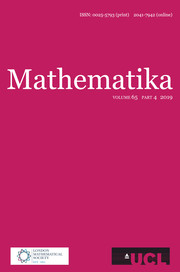Article contents
SIMULTANEOUS APPROXIMATION TO TWO REALS: BOUNDS FOR THE SECOND SUCCESSIVE MINIMUM
Published online by Cambridge University Press: 29 November 2017
Abstract
Introduced in Schmidt and Summerer [Parametric geometry of numbers and applications. Acta Arith.140 (2009), 67–91], approximation exponents  $\text{}\underline{\unicode[STIX]{x1D711}}_{i},\overline{\unicode[STIX]{x1D711}}_{i}$ ,
$\text{}\underline{\unicode[STIX]{x1D711}}_{i},\overline{\unicode[STIX]{x1D711}}_{i}$ ,  $(i=1,2,3)$ , attached to points
$(i=1,2,3)$ , attached to points  $\boldsymbol{\unicode[STIX]{x1D709}}=(\unicode[STIX]{x1D709}_{1},\unicode[STIX]{x1D709}_{2})$ in
$\boldsymbol{\unicode[STIX]{x1D709}}=(\unicode[STIX]{x1D709}_{1},\unicode[STIX]{x1D709}_{2})$ in  $\mathbb{R}^{2}$ , give information on Diophantine approximation properties of these points. Laurent [Exponents of Diophantine approximation in dimension two. Canad. J. Math.61 (2009), 165–189] had described all possible quadruples
$\mathbb{R}^{2}$ , give information on Diophantine approximation properties of these points. Laurent [Exponents of Diophantine approximation in dimension two. Canad. J. Math.61 (2009), 165–189] had described all possible quadruples  $(\text{}\underline{\unicode[STIX]{x1D711}}_{1},\overline{\unicode[STIX]{x1D711}}_{1},\text{}\underline{\unicode[STIX]{x1D711}}_{3},\overline{\unicode[STIX]{x1D711}}_{3})$ arising in this way. Our emphasis here will be on
$(\text{}\underline{\unicode[STIX]{x1D711}}_{1},\overline{\unicode[STIX]{x1D711}}_{1},\text{}\underline{\unicode[STIX]{x1D711}}_{3},\overline{\unicode[STIX]{x1D711}}_{3})$ arising in this way. Our emphasis here will be on  $\text{}\underline{\unicode[STIX]{x1D711}}_{2},\overline{\unicode[STIX]{x1D711}}_{2}$ and the construction of suitable “
$\text{}\underline{\unicode[STIX]{x1D711}}_{2},\overline{\unicode[STIX]{x1D711}}_{2}$ and the construction of suitable “  $3$ -systems”.
$3$ -systems”.
MSC classification
Information
- Type
- Research Article
- Information
- Copyright
- Copyright © University College London 2017
References
- 4
- Cited by

